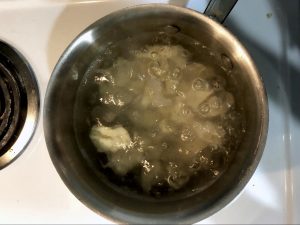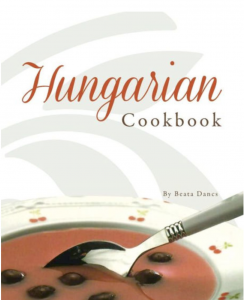Cookbook Review
By Sarah Rosenthal • December 13, 2018
Finding Home in Hungarian Cuisine
A review of Hungarian Cookbook by Beata Dancs
Beata Dancs was born and raised in Hungary, but moved to Australia about twenty years ago. It was only after moving to Australia that Dancs learned of her love for cooking; there, she met and had potlucks with her similarly multicultural neighbors, and they would cook and share meals from their native countries. Soon, her entire neighborhood fell equally in love with her Hungarian cooking, so she shared her heritage with them by scribbling her recipes on notecards and scraps of paper. For a while, they were satisfied with these recipes, but soon they were craving even more! So when Dancs went to purchase a Hungarian cookbook for them but came back empty-handed from the bookstore, she took it upon herself to write one. Dancs’s Hungarian Cookbook is the result of this passion project.
Dancs wrote Hungarian Cookbook for someone who is encountering and attempting to cook Hungarian cuisine for the first time. She breaks the table of contents into simple and recognizable courses, with relatively few recipes under each course to avoid overwhelming the reader. For example, there are eight different types of dumplings, four “special vegetables,” and five desserts. There are hundreds of dishes which are unique to the Hungarian cuisine, but this cookbook serves as just an introductory volume to the cuisine. It hits the highlights, including both the author’s favorite recipes and more traditionally famous ones.
Even more evidence for the cookbook’s intended audience is the short section immediately following the table of contents called “useful information.” Here, the author writes specifically about the types of ingredients to use, such as the type of smoked bacon used in Hungarian dishes and how to find it at Eastern European butcher shops. Of course, no Hungarian cookbook would be complete without a note about the importance of using Hungarian paprika, so that falls in this section as well. Additionally, Dancs uses this space to bring some of her unique cultural understanding into the book: she clarifies the meanings of some common Hungarian words which don’t have English translations and even notes the soup course’s importance to a Hungarian meal.
As the brief introductory material comes to a close, Dancs wastes no time delving right into the recipes. She clearly labels each dish, and introduces each one with a short snippet about the recipe’s use in a Hungarian meal, possible substitutions or additions, cultural context for the dish, or a personal recommendation. Because of these short interludes and opinions before each dish’s ingredient list, the book has a very friendly tone. In fact, this charm reminds me a lot of my family’s cookbook, where my mom made sure to include suggestions, tips, and stories from the author of each recipe. It feels very personal, and because of this, it’s evident that Dancs is proud to share her heritage and its cuisine.
These personal touches point back towards the book’s original and very endearing purpose: to act as a comprehensive source of her best Hungarian recipes for Dancs’s own friends in Australia. Of course, along with this purpose comes a certain informality which means this cookbook will never be a widely-circulated, popularly-reviewed one. There are some obvious typos (how do you “slimmer” a sauce for an hour?), some oddly-specific measurements (am I really going to sit and pick out exactly “20 peppercorns” to use in my pork jelly?), and some occasionally ambiguous instructions, which I have to admit did confound my understanding of the galuska recipe I followed to test the book myself, even though I’ve made the buttery dumplings before.
Perhaps more photographs and longer, sensory-detailed recipe narratives would have helped ease the few complaints I have about this book, but I also understand that Dancs is an insightful Hungarian-Australian who just knew her friends wanted a Hungarian cookbook and wrote one. That’s the true appeal of Hungarian Cookbook, and even the occasionally obscure directions add to the experience of cooking as the Hungarians do: through experimentation, taste, and feeling, rather than through imitation.

I did have the opportunity to test Dancs’s recipe for galuska, and I was extremely pleased with the recipe and its results! As she instructs, I mixed my flour-based dough and let it rest for half an hour before cutting and shaping it into small chunks to drop into a pot of boiling water. Once I dropped the dumplings into the water, that intuition and experimentation I mention needing to use this cookbook became very clear: Dancs’s only instructions are to “skim them off the top of the water,” and had I not made galuska before, I probably would have wanted another clue based on time or texture to test for doneness. However, the galuska really do drop to the bottom of the pot when raw and bubble up to the surface when they’re ready to be scooped out, mixed with butter and salt, and served, and there’s a certain satisfaction to figuring out these things on your own. Indeed, the trial and error does pay off, because the galuska’s dense, rich texture and flavor are the perfect comfort food.

Overall, I wouldn’t hesitate to recommend Beata Dancs’s cookbook to the new Hungarian cook. Her neighborly and approachable tone gives each recipe its own life, even when their similar ingredients make them seem so similar to one another. However, although the book is intended for the new Hungarian cook, even those with strong Hungarian heritage will appreciate Hungarian Cookbook’s comfortable tone. It might even bring you back to your roots the same way that it brought Dancs back to hers.

